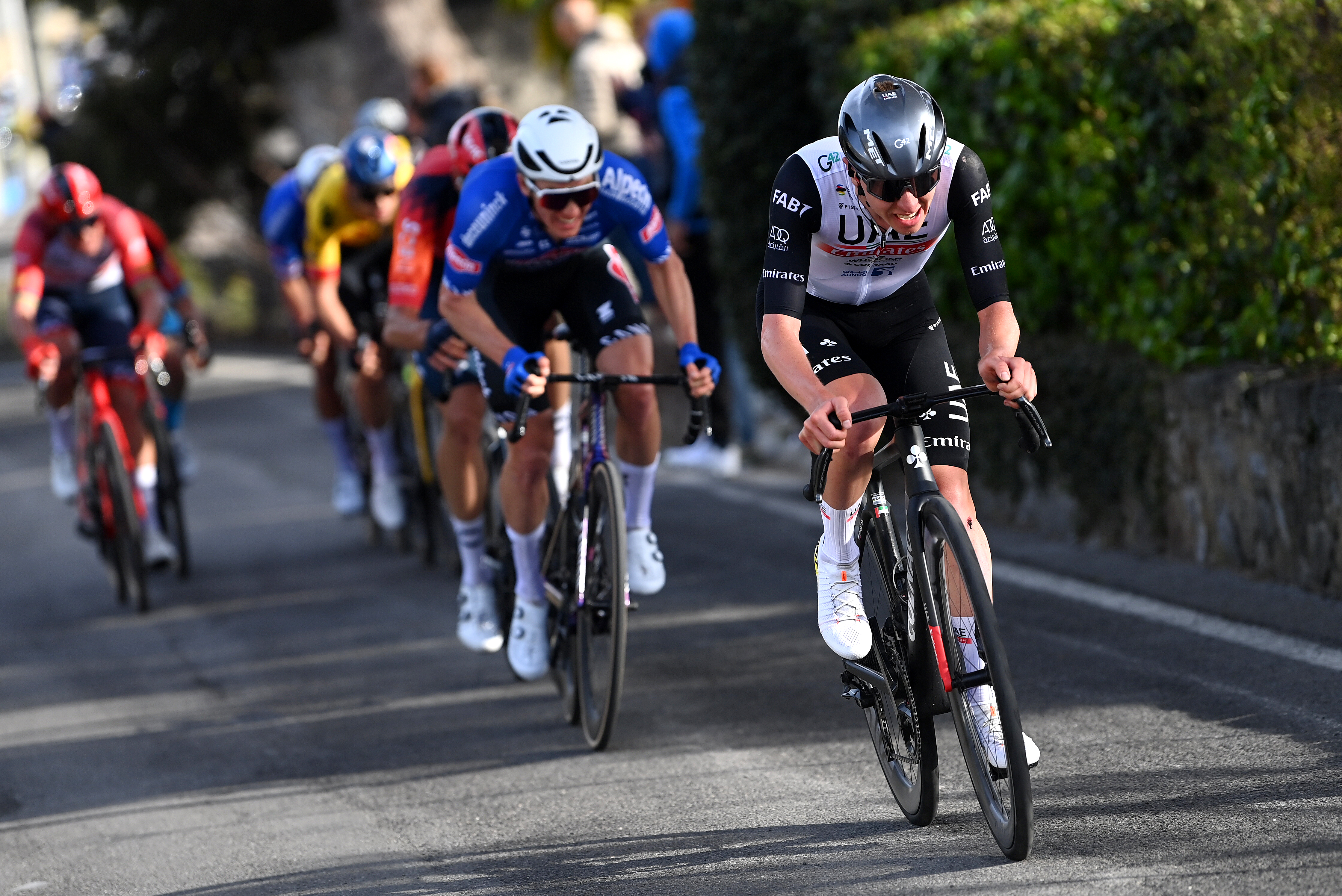Analysis: How Mathieu van der Poel won Milan-San Remo
After another exhilarating finish to Milan-San Remo, it’s time to look back at the day and the key tactical moments that defined it


Another thrilling Milan-San Remo finale demands we look back over it. This is not an attempt to be Captain Hindsight, it’s a chance to look back at the tactics of the day, if they were successful and why teams chose to take this approach.
Most people expected UAE Emirates to smash the Cipressa, just like they did last year, where they reduced the bunch to just 30 riders, but that didn’t happen this year. They did pace the climb, and sacrificed Felix Großschartner, but the pace wasn’t super high. The thinking behind this was to save more men for the Poggio, it was going to be an all or nothing move on the final climb.
While everything seemed to be going to plan for UAE Emirates, Jumbo-Visma were forced into some last-minute changes. Jan Tratnik crashed with 30km to go and wouldn’t be a feature late in the race. The problem was that Tratnik was likely to be the final man for Wout van Aert, someone to potentially help him chase down any moves.
The sports directors in the car would have been frantically trying to think about what they could do, the hope would have been that Christophe Laporte could potentially do that job, but he’d already used up a lot of energy helping to position van Aert. This is a prime example of how a piece of bad luck can severely impact team tactics, van Aert was alone at the key point on the Poggio, but we’ll never know what would have happened if Tratnik had survived.
On the Poggio, we got the expected move by Tadej Pogačar. He and Tim Wellens launched to the front with 2.4km of the Poggio still to go, this was the move of the day. All the big players were in a good position for this attack, except for van Aert, he had to use up energy moving up a few positions.
With 1.2km left of the climb, Matteo Trentin played a blinder. The Italian was sitting 9th wheel when Wellens was pushing on the front, he swung over creating a swiftly opening gap, and it was game over for everyone behind him. This left an elite group of Wellens, Pogačar, Søren Kragh, Filippo Ganna, Mads Pedersen, Matej Mohorič, Mathieu van der Poel and Van Aert, it really was a clever move by the veteran Trentin.

The Pogačar attack came just after, with 1.1km left of the Poggio. He dragged Kragh and Ganna with him, while Pedersen and Mohorič went backwards. This created a small gap, and as van der Poel had a teammate in the move, Van Aert had to close the gap, it was another effort he shouldn’t have had to make.
The latest race content, interviews, features, reviews and expert buying guides, direct to your inbox!
As soon as the gap was closed, Kragh dropped from the front and we were left with four team leaders: Pogačar, Ganna, Van Aert and van der Poel. At this point, Pogačar continued to lead the group without asking for anyone else to take a turn, they had a big enough gap for him to pull over and save a little energy but he chose not to.
Within sight of the crest came the race winning move, when van der Poel went up the inside of a corner and burst to the front. Van Aert was immediately gapped, and despite trying, Pogačar couldn’t close the gap, he was still suffering from launching the big attack one minute earlier. When van der Poel turned onto the descent, he only had a gap of three seconds, it was touch and go.
On the descent, he went full, while the others looked to Van Aert to take the lead. Just at the foot of the descent the chase group started to look at each other and van der Poel had a gap of five seconds, around a hundred metres at that speed, it was game over.
On the flat the chasing three tried to work together, but powerhouse Ganna wasn’t taking full turns, there was no way they’d get back to van der Poel.
Looking back, UAE Team Emirates did everything just about right. Wellens put everyone into difficulty, Trentin cleverly created a gap for the front group and Pogačar launched a huge attack that dropped most of his rivals. The one mistake was remaining on the front for the rest of the Poggio, he couldn’t see the van der Poel attack until it was too late.
Van Aert made the most mistakes of all the big hitters. His position when Wellens moved to the front was poor, he used energy moving back up the line. He then decided to wait in around eighth wheel, which was too far back when he knew Pogačar was going to attack. At this point, he again used up vital energy to close a gap. It’s possible this is why he couldn’t respond to the van der Poel move, but remember, he was missing Jan Tratnik.
By comparison Alpecin-Deceuninck raced a near flawless race. Søren Kragh had a good position when Pogačar made his move, he was sitting third wheel and this allowed van der Poel to force Van Aert into closing a gap, allowing him to save energy.
When the time came, van der Poel had enough energy to launch an attack that no one could respond to, it helped that he came from last place in the group, they didn’t see it coming. Not only did he have the best legs but van der Poel rode a clever race. The best man won.
David is a cycling fan, pure and simple. For the last 10 years he’s been writing previews for all races and also has a successful podcast where he interviews the stars of cycling. When he’s not watching or writing about cycling he’s thinking about it.
